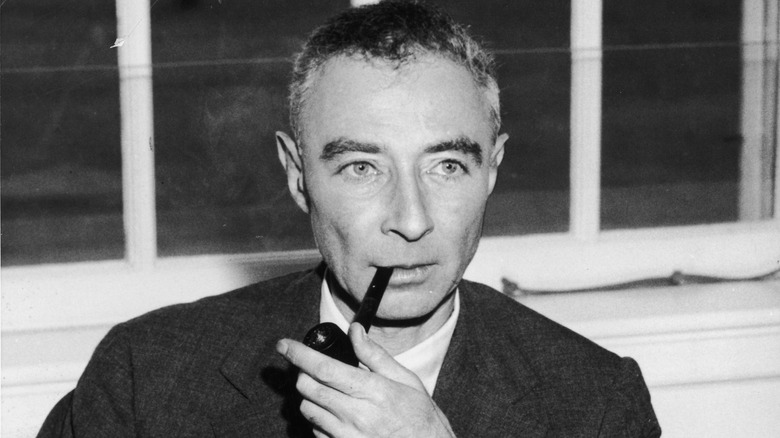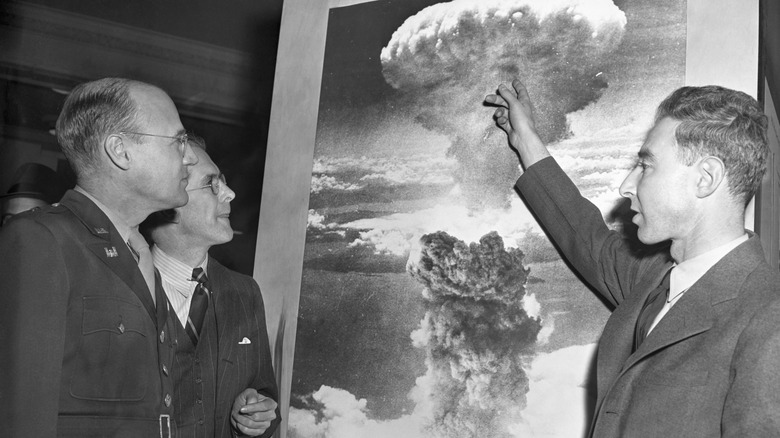Why You Can't Visit J. Robert Oppenheimer's Grave
The new Christopher Nolan "Oppenheimer" movie has renewed more than its fair share of curiosity about its eponymous character, J. Robert Oppenheimer. Even if folks know nothing else about Oppenheimer, they've definitely seen him staring dead ahead toward the camera, stricken with bottomless despair, quoting the Indian Vedic text the Bhagavad Gita: "Now I am become Death, the destroyer of worlds." Of course, there's a lot more to Oppenheimer and his life besides hopelessness at having headed up the Manhattan Project that produced the world's first atomic bomb explosion — "Trinity" — at Alamogordo, New Mexico on July 16, 1945. Oppenheimer was a complicated person with complicated beliefs that persisted all the way to his death and the fate of his very body.
Case in point: Oppenheimer's Bhagavad Gita quote. Wired describes the true meaning of the quote, which has gotten misinterpreted over time. The quote comes up in conversation between a warrior, Arjuna, and the Hindu god Krishna. It ultimately means, "Leave everything to God because life and death are illusions." But even though Hinduism is rooted in reincarnation and self-improvement, Oppenheimer couldn't bring himself to believe in an immortal soul. Death was annihilation, just like his bomb.
So when Oppenheimer died, he took "ashes to ashes, dust to dust" literally. Rather than leave anything behind to preserve or memorialize, he chose to be cremated. His ashes were scattered near St. John in the Virgin Islands. So if you ever wanted to visit Oppenheimer's grave — you can't.
Oppenheimer's retreat from humanity
Strictly speaking, if you want to visit the place where J. Robert Oppenheimer's remains were deposited, you could head to St. John's in the Virgin Islands and swim around a bit. More specifically, you'll want to head to Oppenheimer Beach on St. John's northwestern edge, a gorgeous stretch of pale beach aside crisp blue waters totally at odds with the tortured, ugly brutality of the atomic bomb. As the BBC explains, this is where Oppenheimer hid away from humanity in the last years of his life from 1955 till his death in 1967. Oppenheimer wasn't alone, though. He lived with his wife Kitty, his daughter Toni, and his son Peter on a two-acre plot in a modest, one-story house while writing poetry and sailing between nearby islands. As the name implies, Oppenheimer Beach wasn't exactly populated back in those days and got named after Oppenheimer himself.
And make no mistake: Oppenheimer was indeed hiding away from humanity on St. John's. After witnessing the hell that he helped unleash, Oppenheimer adopted an anti-nuclear stance and became ideologically communist. But because he was so deeply tied to American military secrets the FBI kept him under constant surveillance. Part of the reason he fled to St. John's, per the BBC, was the desire to escape the incessant eye of the U.S. government. He couldn't be tracked on St. John's, not easily, and not on an underdeveloped island that had just become a U.S. territory less than 40 years prior.
Final days of peace
J. Robert Oppenheimer didn't choose to purchase land on Hawksnest Bay, St. John's just because it was safe from the FBI, "a backwater," and "a great place to hide out and be anonymous," as Oppenheimer family friend David W. Knight says on the BBC. The decision was motivated by practical concerns about nuclear war, as well. Oppenheimer reasoned that the Virgin Islands would be "one of the last places affected by nuclear fallout." Thankfully, he wouldn't live to see such days.
Per the BBC, Oppenheimer died from throat cancer in 1967 at 62 years old. Many pictures of him show him clenching a pipe in his teeth or with a cigarette dangling from his lips — all of his smoking must have caught up with him. His wife Kitty carried his ashes via boat out to a favorite spot of his – Carval Rock – northwest from Oppenheimer Beach. There she threw her husband's ashes into the ocean. Five years later in 1972, Oppenheimer's daughter Toni did the same thing for her mother. Five years later in 1977, Toni took her own life. She left in her family cottage on the beach a handwritten note gifting the property "to the people of St. John."
Nowadays, anyone can visit Oppenheimer's Beach on St. John's and see the dead physicist's house, which has been renovated and is now used as a community center, or gaze out toward the direction where his ashes joined with the sea. To Oppenheimer, that's the last place he ever was or ever could be.


